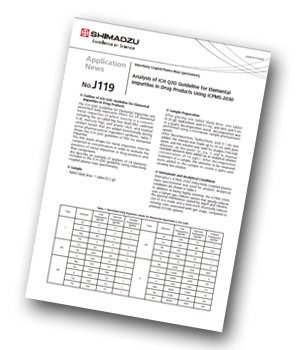Shimadzu has produced an application note describing an example of analysis of 24 elements included in the ICH Q3D guideline using inductively coupled plasma mass spectrometry.
 Introduction
Introduction
The ICH Q3D Guideline for Elemental Impurities sets permitted daily exposures (PDEs) for 24 elemental metal impurities of which toxicity is a concern, including the so-called big four (lead (Pb), cadmium (Cd), mercury (Hg), and arsenic (As)), and residual catalyst metals that are added intentionally during active pharmaceutical ingredient synthesis. The PDE levels shown for metal impurities must be converted to concentrations in order to evaluate the presence of metal impurities in drug products and their components.
About the Instrument
Shimadzu's ICPMS-2030 inductively coupled plasma mass spectrometer was used for the analysis of one tablet (daily dose: 1 tablet [0.2 g]). In addition to being highly sensitive, the ICPMS-2030 uses a helium gas collision system that greatly reduces the spectral interference caused by argon and chlorine. Use of Eco mode and a mini-torch drastically reduces running costs associated with gas usage, compared to previous ICP-MS systems.
Analysis
Quantitative analysis and spike and recovery testing were performed for 24 elements included in ICH Q3D Guideline. Analyses were performed by the calibration curve method and internal standard method.
Results and Conclusion
Good spike and recovery results were obtained for all samples. Detection limits converted into
sample concentrations also met all permitted concentration levels. Twenty four elements included in the ICH Q3D Guideline were successfully and accurately analysed in a short period of time using the ICPMS-2030.
